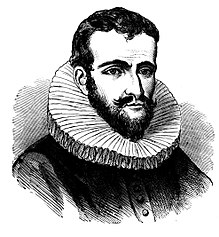| Revision as of 20:58, 7 October 2008 view sourceIanhofmann (talk | contribs)14 edits →1607 to 1609← Previous edit | Revision as of 20:59, 7 October 2008 view source Ianhofmann (talk | contribs)14 edits →1607 to 1609Next edit → | ||
| Line 31: | Line 31: | ||
| === 1607 to 1609 === | === 1607 to 1609 === | ||
| In 1607, the ] of England hired Hudson to find the ] to ]. Hud | In 1607, the ] of England hired Hudson to find the ] to ]. Hud | ||
| '''IM A DORK!!!!!!!!!!!!!!!!!!!!!!!!!!!!!''' | |||
| === 1610-1611 === | === 1610-1611 === | ||
Revision as of 20:59, 7 October 2008
| Henry Hudson | |
|---|---|
 | |
| Allegiance | English |
Henry Hudson (1570 – 1611) was an English sea explorer and navigator in the early 17th century.
Biography
Hudson was born in London, England. He is presumed to have died in 1611 in Hudson Bay, Canada, after he was set adrift, along with his son and seven others, by his crewmen following a mutiny.
Hudson's early life is fairly unknown, but he is thought to have spent many years at sea. He is said to have begun as a cabin boy at 16 and gradually worked his way up to ship's captain.
1607 to 1609
In 1607, the Muscovy Company of England hired Hudson to find the Northeast Passage to China. Hud
IM A DORK!!!!!!!!!!!!!!!!!!!!!!!!!!!!!
1610-1611
In 1610, Hudson managed to get the backing for yet another voyage, now under the English flag. The funding came from the Virginia Company and the British East India Company. At the helm of his new ship, the Discovery, he stayed to the north (some claim he deliberately went too far south with the Dutch), reaching Iceland on May 11, the south of Greenland on June 4, and then managing to turn around the southern tip of Greenland.

Excitement was very high due to the expectation that the ship had finally found the Northwest Passage through the continent. On June 25, the explorers reached the Hudson Strait at the northern tip of Labrador. Following the southern coast of the strait on August 2, the ship entered Hudson Bay. Hudson spent the following months mapping and exploring the eastern shores. In November, however, the ship became trapped in the ice in James Bay, and the crew moved ashore for the winter.


When the ice cleared in the spring of 1611, Hudson planned to continue exploring. However, his crew wanted to return home. Matters came to a head and the crew mutinied in June 1611. They set Hudson, his teenage son John, and eight crewmen - either sick and infirm, or loyal to Hudson - adrift in a small open boat. According to Abacuck Prickett's journal, the castaways were provided with powder and shot, some pikes, an iron pot, some meal, and other miscellaneous items as well as clothing. However, Prickett's journal was disingenous insofar that it was written to be advantageous to the point of view of the mutineers (as they knew they would be tried in England). Some argue that the abandoned men were provided with nothing and expected to die. The small boat kept pace with the Discovery for some time as the abandoned men rowed towards her but eventually Discovery's sails were let loose. Hudson was never seen again.
Only eight of the thirteen mutinous crewmen survived to return to Europe, and although arrested, none were ever punished for the mutiny and Hudson's death. One theory holds that they were considered valuable as sources of information, having travelled to the New World. Henry Hudson has landmarks named after him, including Hudson Bay, Hudson Strait, Hudson County, New Jersey, and the Hudson River.
Notes
Sources
- Hacquebord, Lawrens. (2004). The Jan Mayen Whaling Industry. Its Exploitation of the Greenland Right Whale and its Impact on the Marine Ecosystem. In: S. Skreslet (ed.), Jan Mayen in Scientific Focus. Amsterdam, Kluwer Academic Publishers. 229-238.
- Shorto, Russell (2004), The Island at the Center of the World, Vintage Books, ISBN 1-4000-7867-9
See also
External links
- Biography at the Dictionary of Canadian Biography Online
- Henry Hudson - A Brief Statement Of His Aims And His Achievements by Thomas Allibone Janvier, at Project Gutenberg
- Hudson and the river named for him
- Henry Hudson biography page
- Henry Hudson at US-History.com
- Template:Find A Grave
- A Map and Timeline of Hudson's 1609 voyage of discovery.